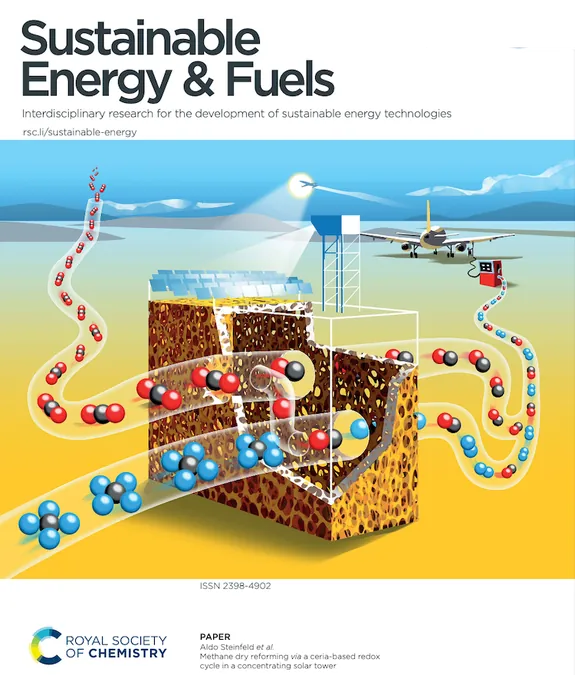
Revolutionary Solar Syngas Technology Poised to Transform Energy Market
2025-01-16
Author: Nur
In a groundbreaking achievement, researchers from ETH Zurich, IMDEA Energy, and Synhelion have successfully demonstrated the production of solar syngas with impressive efficiency and selectivity, marking a significant step toward sustainable fuel solutions.
The global shift to renewable energy has successfully replaced fossil fuels for electricity generation, but the challenge remains in producing liquid transportation fuels such as gasoline and aviation fuel using solar energy. The secret lies in sustainable drop-in fuels—synthetic liquid hydrocarbons derived from syngas, which is composed of hydrogen and carbon monoxide.
International researchers are making remarkable progress in producing syngas sustainably by harnessing concentrated solar thermal energy. This innovative method utilizes heat to drive a thermochemical process that converts water and biogas into syngas, potentially revolutionizing the fuel market.
The Power of Moderate Temperatures: A Game Changer for Solar Fuels
Traditionally, solar syngas production has relied on high temperatures, with processes running at around 1500°C for reduction and 1000°C for oxidation using concentrated solar heat. However, the ETH Zurich team, supported by funding from the Swiss Federal Office of Energy, has explored a more practical approach that can maintain both reduction and oxidation steps at moderate temperatures around 1000°C.
Lead researcher Mario Zuber emphasized the benefits of this method: “Working at lower reduction temperatures simplifies the materials needed, facilitating a smoother transition to industrial applications. Demonstrating the technical feasibility at such temperatures is a critical step before tackling the harsher conditions typically required for water and CO2 splitting.
An Innovative Demonstration of Solar Syngas Production
A collaborative demonstration project at a 500-sun concentrating solar tower located at IMDEA Energy in Spain has showcased this innovative approach. The solar tower utilizes 169 heliostats—sun-tracking parabolic mirrors—that can collectively deliver up to 250 kW of solar radiative power. For this experiment, 38 heliostats were operational, effectively delivering 10 kW of solar power to the solar reactor.
The reactor's design incorporates two reaction zones. The first step involves splitting water and CO2 through a ceria-based redox cycle, while the second utilizes a pioneering "dry redox reforming" technique, allowing for the simultaneous production of syngas at a consistent temperature of 1000°C.
Zuber explained, “By integrating methane in the reduction step, we eliminate the drastic temperature fluctuations of traditional methods, achieving more continuous and efficient syngas production.”
Impressive Results and Future Prospects
The outcomes of the collaborative project were impressive, with peak methane conversion rates reaching 70% and an overall solar-to-fuel energy efficiency of 16%. Furthermore, the new method allows for continuous production, enabled by the storage of solar thermal energy, critical for many industrial processes that require uninterrupted operation.
However, the research team emphasizes the importance of sustainability. Zuber noted that it is essential for methane to come from biogenic sources, ensuring that the entire process aligns with environmental sustainability principles.
This innovative leap in solar syngas production not only holds promise for reducing carbon footprints but also positions sustainable aviation fuels and other liquid fuels as viable alternatives in the energy market. As industries look to minimize their environmental impact, such advancements are critical in paving the way toward a greener, more sustainable future.
Is the Solar Fuel Revolution On the Horizon?
As solar technologies continue to advance, the transition to renewable energy sources may be closer than we think. With companies like Synhelion leading the charge, the dream of producing clean, sustainable jet fuels and liquid hydrocarbons from solar energy could soon be a reality! Stay tuned for more updates on this exciting development in energy sustainability!


 Brasil (PT)
Brasil (PT)
 Canada (EN)
Canada (EN)
 Chile (ES)
Chile (ES)
 Česko (CS)
Česko (CS)
 대한민국 (KO)
대한민국 (KO)
 España (ES)
España (ES)
 France (FR)
France (FR)
 Hong Kong (EN)
Hong Kong (EN)
 Italia (IT)
Italia (IT)
 日本 (JA)
日本 (JA)
 Magyarország (HU)
Magyarország (HU)
 Norge (NO)
Norge (NO)
 Polska (PL)
Polska (PL)
 Schweiz (DE)
Schweiz (DE)
 Singapore (EN)
Singapore (EN)
 Sverige (SV)
Sverige (SV)
 Suomi (FI)
Suomi (FI)
 Türkiye (TR)
Türkiye (TR)
 الإمارات العربية المتحدة (AR)
الإمارات العربية المتحدة (AR)